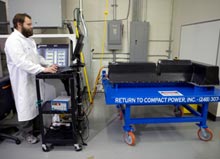A Second Life for Old Vehicle Batteries
Major automakers are looking for new ways to drive down the cost of batteries for electric vehicles and plug-in hybrids. GM and Nissan, which will both start selling electric and hybrid vehicles at the end of the year, have announced partnerships that they hope will find new applications for the batteries after they’ve outlived their usefulness for powering vehicles.

Last week Nissan announced a joint venture with industrial giant Sumitomo. GM followed suit with a similar announcement this week–it’s teaming up with ABB, a leading supplier of equipment for the electrical grid. Under these partnerships, Nissan and GM will study various possible energy-storage applications for partly depleted vehicle batteries.
At the end of this year, GM will start selling the Chevrolet Volt, an electric car that can drive 40 miles on the energy stored in its lithium-ion battery and 300 more on electricity generated by its gasoline engine (the car is known as a plug-in hybrid). Nissan will also deliver the Leaf sedan at the end of the year–a battery-powered car with a range of approximately 100 miles (although the range can be much lower if the heater is on and the stereo blaring).
The battery in an electric vehicle or a plug-in hybrid can cost about as much as a small car–$10,000 to $15,000. This fact, combined with the high cost of developing these vehicles, will make them unprofitable for several years, says Michael Omotoso, manager of the power train forecasting group at J.D. Power and Associates. So finding applications for used vehicle batteries could provide automakers with valuable additional revenue.
Automakers expect that most vehicle batteries ready for replacement will still be able to store between 50 percent and 80 percent of the energy that they could when they were brand-new. That storage capacity could be valuable for a number of applications. The batteries could be used as backup power supplies for data centers or for communities that are prone to power outages. They could also be used to help stabilize the grid, smoothing out fluctuations in supply and demand and potentially storing electricity generated by solar panels and wind farms for use during times of peak demand.
There’s not much demand for used lithium-ion automotive batteries now, Omotoso says. But demand is expected to grow as more sources of renewable energy come on line.
Mark Duvall, director of electric transportation and energy storage at the Electric Power Research Institute in Palo Alto, California, says electric utilities are starting pilot projects that use lithium-ion batteries. But they could be ready to use them more widely by the time used batteries become available in large numbers. “The timing of this work in the auto industry is very good,” he says.
The new partnerships announced by GM and Nissan will help the automakers figure out how to reap the benefits of depleted batteries, answering questions such as whether the batteries need to be disassembled and repackaged, how well they will work for different applications, and what applications could be the most lucrative. Storing large amounts of energy for hours or days is a very different task from quickly charging and discharging large amounts of power. Duvall says that companies may be willing to pay relatively high prices for batteries for some applications, such as backing up a data center.
It’s not clear exactly how much these applications can defray the cost of the batteries. “It’s a cloudy crystal ball,” says Micky Bly, GM executive director of electrical systems. For now, he says, government incentives will help cars such as the Volt compete, but those incentives will eventually expire. To compete without incentives, the cost of using batteries will have to come down from where it is today–between $500 and $1,000 per kilowatt hour–to $200 to $300 per kilowatt hour.
Bly expects used-battery proceeds to account for “single-digit percentages” of these savings. (The rest of the savings will need to come from other areas, such as improved battery technology, and lower costs that accompany larger-scale production.)
Reaping profits from used batteries “has been a nice vision for many years,” says Menahem Anderman, founder of Total Battery Consulting, based in Oregon House, California. But he says he has yet to see a viable plan for doing it. It’s hard to predict how long an eight-year-old battery will last, he says, or how safe it will be. And the economic value will be limited by the fact that the batteries will need to be tested, shipped, and supported by warranties, he says. So he expects the batteries’ residual value will be “well below $100 per kilowatt hour, probably below $50 per kilowatt hour”–less than 10 percent of the cost of a battery today.
Keep Reading
Most Popular
Large language models can do jaw-dropping things. But nobody knows exactly why.
And that's a problem. Figuring it out is one of the biggest scientific puzzles of our time and a crucial step towards controlling more powerful future models.
The problem with plug-in hybrids? Their drivers.
Plug-in hybrids are often sold as a transition to EVs, but new data from Europe shows we’re still underestimating the emissions they produce.
Google DeepMind’s new generative model makes Super Mario–like games from scratch
Genie learns how to control games by watching hours and hours of video. It could help train next-gen robots too.
How scientists traced a mysterious covid case back to six toilets
When wastewater surveillance turns into a hunt for a single infected individual, the ethics get tricky.
Stay connected
Get the latest updates from
MIT Technology Review
Discover special offers, top stories, upcoming events, and more.